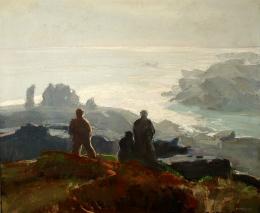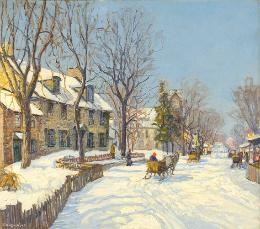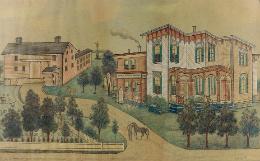Rising From The Sea: The Art of Jay Hall Connaway
|
August 22, 2011 - May 20, 2012
Jay Connaway (1893-1970) painted in an era marked by the economic, political and social upheaval of World War I, the Great Depression and World War II. He painted in a bold Impressionist style and critics in the 1920s called him “the greatest sea painter since Winslow Homer.” Under the patronage of Bartlett Arkell, president of Beech-Nut Corporation and founder of the Canajoharie Library and Art Gallery, Connaway painted in Brittany, France. Arkell later provided Connaway with a house on the remote island of Monhegan, Maine. This exhibition includes paintings inspired by both the coastline of Monhegan Island and the landscape of Vermont. |
Jay Connaway
Trouble |
American Paintings from the 1920s & 1930s in the Arkell Collections
|
August 26, 2011 - March 24, 2012
American Artists in the 1920s and 1930s painted in a broad range of Realist, Impressionist and modern styles. Most of the paintings in this exhibition were purchased by Bartlett Arkell, the founder and first president of Beech-Nut Packing Company. Arkell began to collect paintings for the museum in the mid-1920s. This was a time when many American painters continued to work in styles influenced by the French Impressionists, while others were encouraged by Ashcan School artists to explore greater realism. During the 1930s, American artists became more interested in organic and geometric abstraction, but abstract art had a limited appeal with the public. Arkell favored Realist and Impressionist works that presented nostalgic views of America unchanged by industry - not avant-garde art. He acquired paintings by Impressionist and Ashcan School artists who had once shocked people with their controversial subject matter, but by the 1920s were hailed as America's greatest artists. |
E.W. Redfield
Sleigh Bells, c. 1920 |
Drawn to the Same Place: The Drawings of Rufus Grider and Fritz Vogt 1885 - 1900
|
April 1, 2011 - August 14, 2011
Rufus Grider (1817-1900) and Fritz Vogt (1842-1900) sketched the farms, homes, stores and churches found in the Mohawk Valley. These two remarkable vernacular artists, whose personal stories and motivations could not have been more different, documented buildings and landscapes in the same rural New York region during 1890-1900. They were both German-speakers who came to the Mohawk Valley as adults. Grider, a Canajoharie schoolteacher, studied early accounts of the Mohawk Valley in an effort to reconstruct the past and document his interest in the fast-changing landscape. Vogt was an itinerant handyman and artist who produced his portraits of farms and homes as a way to earn a living. While they created their sketches for different reasons, their works viewed together provide us with a clear picture of of the past. Exhibition funded, in part, by the New York Council for the Humanities, and by the Iroquois Gas Transmission System. |
Fritz Vogt
Residence of Mr. and Mrs. F. Snell, Minden, NY, July 31, 1895 Collection of Frank Tosto |



